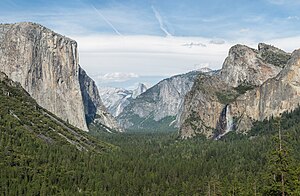Yosemite National Park, California
| Yosemite National Park | |
|---|---|
|
IUCN category II (national park)
|
|

Yosemite Valley from Tunnel View
|
|
| Location | Tuolumne, Mariposa, & Madera counties, California, U.S. |
| Nearest city | Mariposa, California |
| Coordinates | 37°51′N 119°33′W / 37.850°N 119.550°WCoordinates: 37°51′N 119°33′W / 37.850°N 119.550°W |
| Area | 748,036 acres (3,027.19 km2) |
| Established | October 1, 1890 |
| Visitors | 5,028,868 (in 2016) |
| Governing body | National Park Service |
| Website | Official website |
| UNESCO World Heritage Site | |
| Criteria | Natural: (vii), (viii) |
| Reference | 308 |
| Inscription | 1984 (8th Session) |
|
[]
|
|
Yosemite National Park (/joʊˈsɛmɪti/ yoh-SEM-it-ee) is a national park spanning portions of Tuolumne, Mariposa and Madera counties in Northern California. The park, which is managed by the National Park Service, covers an area of 747,956 acres (1,168.681 sq mi; 302,687 ha; 3,026.87 km2) and reaches across the western slopes of the Sierra Nevada mountain range. On average, about 4 million people visit Yosemite each year, and most spend the majority of their time in the 5.9 square miles (15 km2) of Yosemite Valley. The park set a visitation record in 2016, surpassing 5 million visitors for the first time in its history.
Designated a World Heritage Site in 1984, Yosemite is internationally recognized for its granite cliffs, waterfalls, clear streams, giant sequoia groves, lakes, mountains, glaciers, and biological diversity. Almost 95% of the park is designated wilderness. Yosemite was central to the development of the national park idea. First, Galen Clark and others lobbied to protect Yosemite Valley from development, ultimately leading to President Abraham Lincoln's signing the Yosemite Grant in 1864. Later, John Muir led a successful movement to establish a larger national park encompassing not just the valley, but surrounding mountains and forests as well—paving the way for the United States national park system.
...
Wikipedia


